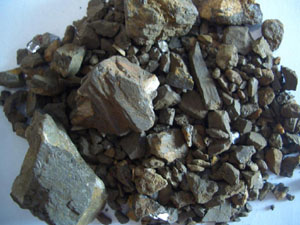Chemical form
Tungsten is silver white, the highest melting point metal, melting point is as high as 3400°C, ranking first among all metals, boiling point 5555°C, specific gravity (monocrystalline tungsten) 19.3, high hardness, good high temperature strength, conductivity and heat transfer performance. Chemical stability at room temperature, corrosion resistance, does not work with ** or **. 
Application area
Tungsten is a high-melting rare metal or refractory rare metal in the field of metallurgy and metal materials. Tungsten and its alloys are one of the most important functional materials in modern industry, national defense, and high-tech applications. They are widely used in aerospace, atomic energy, marine, automotive, electrical, electronics, and chemical industries. In particular, tungsten-containing high-temperature alloys are mainly used in components of gas turbines, rockets, nuclear power plants, and nuclear reactors. High-density tungsten-based alloys are used in anti-tank and anti-submarine armor-piercing warheads.
Tungsten concentrates are used to produce tungsten, tungsten carbide, tungsten alloys and compounds.
Raw material characteristics
Chemical properties and geological effects
Tungsten is a widely distributed element that is found almost everywhere in all types of rock but at low levels.
The mineral deposits can be formed as commodity ore by enrichment through relevant geological actions. The average content of tungsten in the earth's crust is 1.3×10-6, and the average content in tungsten is 1.5×10-6. Tungsten is mainly a hexavalent cation in nature with an ionic radius of 0.68 x 10-10 m. Since W6+ has a small ionic radius, high electricity price, strong polarizability, and easy formation of complex anions, tungsten is mainly in the form of complex anion [WO4]2- and forms scheelite in combination with cations such as Fe2+, Mn2+, and Ca2+ in solution. Sestonite precipitation. The crystallization temperature of wolframite is 320-240°C, and the crystallization temperature of scheelite is 300-200°C.
In the supergene effect, because of the more stable tungsten-containing minerals, sand ores are often formed. However, under acidic conditions, the tungsten-containing minerals can be decomposed and dissolved in surface water in the WO3 form to form certain tungsten secondary minerals under certain conditions. Sometimes it is adsorbed by clay or iron manganese oxide in the form of mineral particles or ions and accumulates in shales, shale fine sandstones, and ferromanganese layers.
In recent years, strata-controlled tungsten deposits and tungsten source beds have been found in ancient metamorphic rock series, suggesting that tungsten can also be enriched to some extent during metamorphism.
Mineral composition
The important minerals of tungsten are tungstates. There are only a few cations that can combine with [WO4]2-complex anion in the process of mineralization, mainly including Ca2+, Fe2+, Mn2+, and Pb2+, followed by Cu2+, Zn2+, Al3+, Fe3+, Y3+, etc. Therefore, the mineral species are limited. At present, only more than 20 kinds of tungsten minerals and tungsten-containing minerals have been found in the earth's crust, namely wolframite minerals: wolframite, wolframite, scheelite; scheelite group: scheelite (calcium tungsten), molybdenum Scheelite, copper scheelite, tungsten-based minerals: tungsten, tungsten, high-tungsten, tungsten-tungsten, copper-tungsten, hydrotungsten; unusual tungsten minerals: tungsten, oblique tungsten Lead ore, molybdenum-tungsten-lead, tungsten-zinc, tungsten-neodymium, neodymium-tungsten pyrochlore, titanium-bismuth-ore (tungsten-containing), *tungsten ore, etc.
Although more than 20 tungsten minerals and tungsten minerals have been discovered, only wolframite and scheelite have economic value. Black wolframite (Fe, Mn) WO4, containing WO3 76%; scheelite CaWO4, containing WO3 80.6%.
Smelting raw materials
The tungsten mines that have been developed abroad for a long time are mainly scheelite, which accounts for 60% of the total production capacity. Although China's scheelite has proved reserves of 3.76 million tons, accounting for 71% of the world's total tungsten reserves, but due to the complexity of the ore material composition of some large, super-large tungsten polymetallic ore deposits, the fine grain size of inlays, and the selection and smelting technology has not yet Completely resolved, so the current stage of mining is still dominated by quartz vein wolframite, accounting for 90% of the amount of ore mined in the country.
Ore industry requirements
Tungsten mineral industry requirements (or mineral industry requirements), including the deposit boundary grade (WO3%), industrial grade (WO3%), the recoverable thickness (m) and the thickness of the stone removed (m).
The associated beneficial components of tungsten deposits are usually tin, molybdenum, bismuth, copper, lead, zinc, antimony, gold, silver, cobalt, antimony, lithium, antimony, bismuth, rare earth, *, phosphorus, arsenic, piezoelectric crystal, smelting crystal. , fluorite and so on. Among them, *, phosphorus, arsenic, molybdenum, calcium, manganese, copper, tin, silicon, iron, tantalum, niobium, lead, zinc and Other tungsten smelting technology and tungsten products are harmful impurities, for various tungsten concentrate products Contains these harmful impurities, the country has established industry standards, namely tungsten mine (18 photos) GB2825-81. Therefore, these harmful components must be collected and smelted to enrich and comprehensively recover, transform pests into benefits, turn waste into treasure, and comprehensively utilize them.
Other
YUYAO CITY YISHENG METAL PRODUCTS CO.,LTD , http://www.alydecor.com